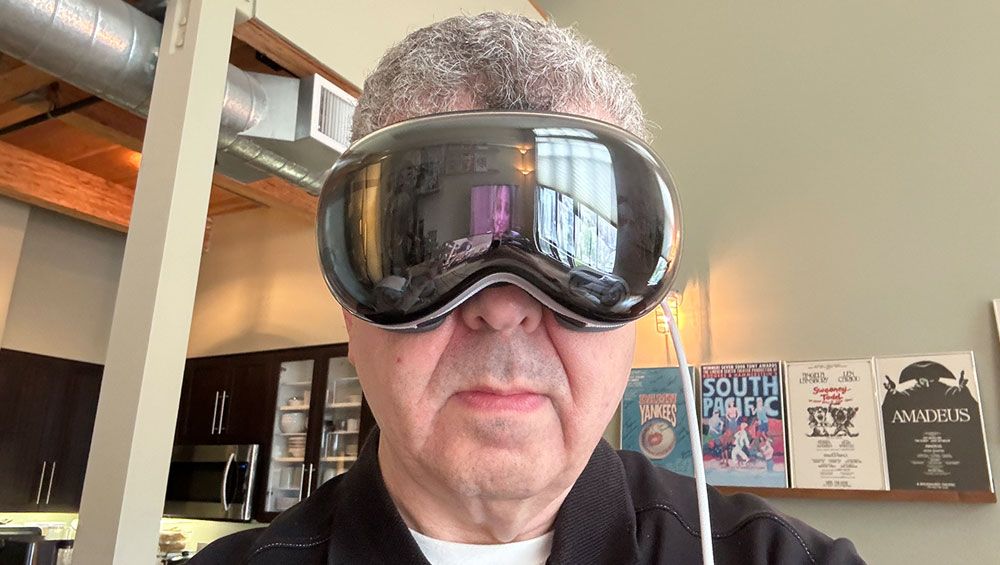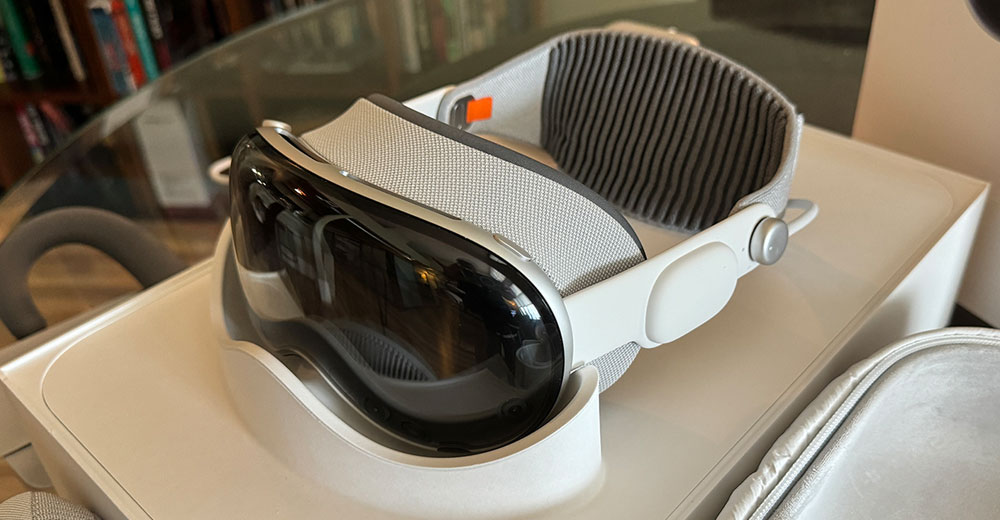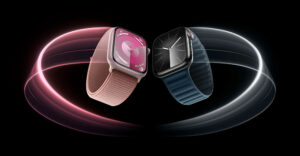No one alive today witnessed the invention of the printing press, telegraph, and telephone — monumental technologies that reshaped communication. In the last century, few innovations have reached such transformative heights. Against this backdrop, Apple Vision Pro stands out as a unique, integrated hardware and software experience that might just survive the test of time.
I know — the $3,499 price tag on Apple Vision Pro is painfully expensive and will be out of the reach of most consumers, despite how cool and useful it might be. Even though I can’t stop using it after a week, it’s not yet a “got to have it” product for everyone, in the footsteps of an Apple iPhone and iPad. However, the product provides a vital, though early, glimpse of what the future will look like. That vision could take a decade or more to become mainstream, but measured against that statement, Apple Vision Pro is a triumph.
Weight, utility, and fit are all highly subjective matters that are impossible to address for the large swath of potential mainstream consumer users. I’ll concede that many users not yet familiar with the Vision Pro headset — possibly more than Apple would like to acknowledge — may find it heavy or unpleasant. It fits on my head, and its weight, which is somewhat lighter than the Meta Quest 3, has not been an issue for me.

While the initial launch of Apple Vision Pro proceeded more or less without a hitch, Vision Pro cannot become an unqualified success until more native apps become available. This point will be a vital test for Apple if the company is going to realize its ambitions for Vision Pro.
Many Viewpoints, Some Conflicting
Having used Vision Pro for about a week as of this writing, my mind is overflowing with various viewpoints. While some of my analyst colleagues might disagree, I’ve tended to take an optimistic position on Vision Pro’s appeal.
Plainly stated, Vision Pro is Apple’s first device for spatial computing. Apple coined “spatial computing” as a marketing slogan when it announced Vision Pro last June, and it’s now become clear to me why after spending some significant time with it.
Even while the Vision Pro technology and design are incredible (easily justifying the high price point), best-in-class AR glasses have always been constrained by the laws of physics and the availability of current components. Today, in its infancy, the Vision Pro platform has boundless possibilities. Still, it will take time for the right killer usage models to emerge and take hold with mainstream users.
The R1 CPU combines with the external cameras and sensors to replicate the user’s space in three dimensions within the displays. Sometimes, you get the impression that you’re not wearing a headset and staring at little displays, but the illusion is broken if the room is too dark. Moreover, paradoxically, the quieter the space where you’re using Vision Pro, the more noise there is. However, that’s essentially why the product is so immersive.
Virtual reality headset aficionados will testify that a “screen door” phenomenon results when the display resolution is not high enough to remove visible pixels when the retina of your eyes gets closer to a monitor.
To mitigate that, Vision Pro distinguishes between being too pixel-dense and removing the impact. Because of the high pixel density, windows, text, and user interface elements appear as sharp as they would on an iPhone. It has to be seen to be believed, as it’s like having two postage-stamp-sized monitors inside the headgear to deliver an immersive visionOS experience.
Field of Vision Not Completely Blocked Out
Interestingly, although wearing the Vision Pro provides a stunning perspective, users will always notice that a room is brighter when you remove it. The immersive settings I used because of the low light levels in my office sometimes made everything look murky. I found that good lighting remedied this situation. Therefore, many Vision Pro users might reconsider the existing ambient lighting in their home offices if they plan on using the product regularly.
Furthermore, the displays you’re viewing still don’t fill the headset, leaving you with a black border around your field of view and without peripheral vision. Currently, no headset can replicate full peripheral vision due to technological limitations.
When something strange enters our field of vision, the human brain is highly adept at focusing on that object and forgetting everything else. Recall that although your nose is constantly visible, the brain works to prevent the user from noticing it.
Vision Pro Is a Powerful Computer in Its Own Right
Apple Vision Pro’s processing power allows it to run powerful applications. There is minimal chance that M2 will become a ceiling for most apps in the near future because visionOS developers have been creating native apps or porting iPad app experiences.
The computing environment would have been even more complicated and unpredictable if Apple had permitted Vision Pro to run Mac software. So, Apple has wisely restricted Vision Pro to run most iOS and iPadOS apps, which has significant battery life and performance advantages.
Although my testing has not been exhaustive, I haven’t found any apps that seem to strain the M2. I was delighted to see many of my favorite iPadOS apps, such as Xfinity Streaming, the OneCast app for Xbox streaming, and Plex, work without a hitch.
VisionOS is not flawless, as it did crash on me a couple of times, though that will diminish in future software and firmware updates. Here’s a short video overview of some of the interesting demos of what I was able to use Vision Pro for in just a few hours:
If I had to single out the one home run Apple has achieved for Vision Pro, it’s unquestionably the product’s user interface.
First, VisionOS has a distinctive iOS/iPadOS look and feel, dramatically shortening Vision Pro’s learning curve. Moreover, reliably and accurately using a person’s eye gaze to select a button with a simple pinch of your fingers is a breakthrough in usability on the scale of using a mouse or touchpad with a traditional desktop operating system. It’s not perfect, but it’s deliciously good and will only improve.
Future Iterations of Vision Pro
Rumors abound that Apple reportedly plans to wait until 2026 to release the Apple Vision Pro 2 or a non-Pro version. That’s probably not a big issue for an inaugural release of a significant platform.
Still, it is a long time to be limited to the M2 processor, particularly when considering more heavyweight apps that get developed and come to fruition. Developers never shy away from more performance power, and I don’t think Vision Pro will be exempt from that reality.
In this regard, Qualcomm may have a price point advantage with its new Snapdragon XR1 as its computing capability may have comparable performance that will surely show up in significantly less-expensive headsets than Vision Pro.
From a sheer platform perspective, Apple Vision Pro and visionOS have limitless possibilities. With the visionOS beta train now officially up and running, it will be simple to forecast where technology will be in a month. Longer-term prognostications will be much more challenging.
Vision Pro is Apple’s first entirely new computer platform since the iPad. Even though the hardware was exclusively released in the United States, things will change rapidly now that it is available to the public. The learnings Apple accrues from observing daily consumer use of Vision Pro will undoubtedly influence future releases of visionOS.
The Inevitable Mainstreaming of Augmented Reality
Most Apple products aren’t the first of their kind; this one is. Vision Pro is not a “fast follower” product as there’s no existing product on the market in its class to follow.
Although Apple has repeatedly used “spatial computing” in its marketing materials, the phrase is not hyperbole and accurately describes what happens when virtual reality is combined with mixed reality. It also reinforces Apple’s belief that augmented reality (AR) will eventually win over mainstream users with practical and compelling usage models.
I must emphasize that software needs to keep up with the new era that Apple Vision Pro heralds. Now that the device offers state-of-the-art screen technology, hand tracking, eye tracking, and passthrough capabilities, developers will have the times of their lives developing apps. For the first, hardware constraints in this product category will not pose a limitation.
Vision Pro Pioneers a New Era of Computing
Vision Pro’s spatial computing functionality represents a groundbreaking leap forward in human-computer interaction, as seamlessly integrating digital content into our physical surroundings transforms how we perceive and interact with information.
No longer confined to traditional screens and interfaces, users can now immerse themselves in a rich, interactive environment where digital and physical worlds converge. This convergence enhances productivity and efficiency and opens new avenues for creativity and innovation.
In essence, Vision Pro’s spatial computing functionality heralds a new era in computing, where the boundaries between the virtual and real blur and the digital realm become an intrinsic part of our everyday lives. As this technology evolves and proliferates, it will impact industries ranging from education to health care to entertainment and beyond.
Ultimately, Vision Pro’s spatial computing has the potential to revolutionize computing as we know it, unlocking boundless possibilities and reshaping the way we work, learn, and play.
Even though Apple Vision Pro is only version 1.0, it may join the rank of the printing press and telephone as seminal technological innovations that have an impact as significant as the Apple II and the original IBM Personal Computer. It will be exciting to see where Apple takes it from here.























































